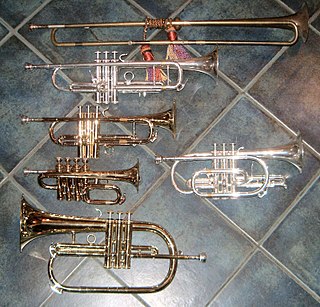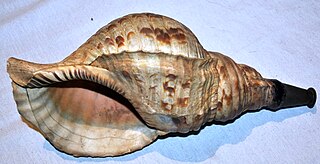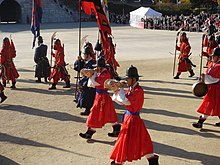
A brass instrument is a musical instrument that produces sound by sympathetic vibration of air in a tubular resonator in sympathy with the vibration of the player's lips. Brass instruments are also called labrosones or labrophones,from Latin and Greek elements meaning 'lip' and 'sound'.

The French horn is a brass instrument made of tubing wrapped into a coil with a flared bell. The double horn in F/B♭ is the horn most often used by players in professional orchestras and bands,although the descant and triple horn have become increasingly popular. A musician who plays a horn is known as a horn player or hornist.

The saxophone is a type of single-reed woodwind instrument with a conical body,usually made of brass. As with all single-reed instruments,sound is produced when a reed on a mouthpiece vibrates to produce a sound wave inside the instrument's body. The pitch is controlled by opening and closing holes in the body to change the effective length of the tube. The holes are closed by leather pads attached to keys operated by the player. Saxophones are made in various sizes and are almost always treated as transposing instruments. A person who plays the saxophone is called a saxophonist or saxist.

The bugle is a simple signaling brass instrument with a wide conical bore. It normally has no valves or other pitch-altering devices,and is thus limited to its natural harmonic notes,and pitch is controlled entirely by varying the air and embouchure.

The ocarina is a wind musical instrument;it is a type of vessel flute. Variations exist,but a typical ocarina is an enclosed space with four to twelve finger holes and a mouthpiece that projects from the body. It is traditionally made from clay or ceramic,but other materials are also used,such as plastic,wood,glass,metal,or bone.

The tenor horn is a brass instrument in the saxhorn family and is usually pitched in E♭. It has a bore that is mostly conical,like the flugelhorn and euphonium,and normally uses a deep,cornet-like mouthpiece.

The mellophone is a brass instrument typically pitched in the key of F,though models in E♭,D,C,and G have also historically existed. It has a conical bore,like that of the euphonium and flugelhorn. The mellophone is used as the middle-voiced brass instrument in marching bands and drum and bugle corps in place of French horns,and can also be used to play French horn parts in concert bands and orchestras.

Conch is a common name of a number of different medium-to-large-sized sea snails. Conch shells typically have a high spire and a noticeable siphonal canal.
Prehistoric music is a term in the history of music for all music produced in preliterate cultures (prehistory),beginning somewhere in very late geological history. Prehistoric music is followed by ancient music in different parts of the world,but still exists in isolated areas. However,it is more common to refer to the "prehistoric" music which still survives as folk,indigenous or traditional music. Prehistoric music is studied alongside other periods within music archaeology.

A pipe is a tubular wind instrument in general,or various specific wind instruments. The word is an onomatopoeia,and comes from the tone which can resemble that of a bird chirping.

Horagai are large conch shells,usually from Charonia tritonis,that have been used as trumpets in Japan for many centuries. The instrument,which has served a number of purposes throughout Japanese history,has been given a number of Japanese names depending on its function. Special schools still teach students to play the traditional music associated with the conch.
The chromatic trumpet of Western tradition is a fairly recent invention,but primitive trumpets of one form or another have been in existence for millennia;some of the predecessors of the modern instrument are now known to date back to the Neolithic era. The earliest of these primordial trumpets were adapted from animal horns and sea shells,and were common throughout Europe,Africa,India and,to a lesser extent,the Middle East. Primitive trumpets eventually found their way to most parts of the globe,though even today indigenous varieties are quite rare in the Americas,the Far East and South-East Asia. Some species of primitive trumpets can still be found in remote places,where they have remained largely untouched by the passage of time.

Daechwita is a genre of Korean traditional music consisting of military music played by wind and percussion instruments,generally performed while marching or as a static performance.

Traditional Cambodian musical instruments are the musical instruments used in the traditional and classical music of Cambodia. They comprise a wide range of wind,string,and percussion instruments,used by both the Khmer majority as well as the nation's ethnic minorities.

The pūtātara is a type of trumpet used by the Māori people of New Zealand. It is customarily made with a carved wooden mouthpiece and a bell made from New Zealand's small native conch shells or triton shell. Larger pūtātara were particularly prized as the triton shell was rarely found and only sometimes washed up on the beaches in the Far North. It is often blown in guest welcoming ceremonies.

Hom is a Yucatec Maya name used for a class of trumpet-like musical wind instruments found in pre-Columbian and traditional music among the Maya peoples of Mesoamerica. These may be gourd trumpets,horns,megaphones,bugles (cornetas),bocinas or sacabuches,and are seen depictd on the Bonampak murals. Most conspicuous are the hom-tahs or large horns,made from wood,clay and gourds.

Conch,or conque,also known as a "seashell horn" or "shell trumpet",is a wind instrument that is made from a conch,the shell of several different kinds of sea snails. Their natural conical bore is used to produce a musical tone. Conch shell trumpets have been played in many Pacific Island countries,as well as South America and Southern Asia.

Modern didgeridoo designs are distinct from the traditional Australian Aboriginal didgeridoo,and are innovations recognized by musicologists. Didgeridoo design innovation started in the late 20th century using non-traditional materials and non-traditional shapes. The design changes include features that are similar to more familiar musical instruments like the trombone and natural horn.

A horn is any of a family of musical instruments made of a tube,usually made of metal and often curved in various ways,with one narrow end into which the musician blows,and a wide end from which sound emerges. In horns,unlike some other brass instruments such as the trumpet,the bore gradually increases in width through most of its length—that is to say,it is conical rather than cylindrical. In jazz and popular-music contexts,the word may be used loosely to refer to any wind instrument,and a section of brass or woodwind instruments,or a mixture of the two,is called a horn section in these contexts.

The sneng or snaeng is an aerophone made from an ox horn or water buffalo horn. It is loud enough to call across a distance and has been used in rural environments to signal mealtimes,give warning,call for help or indicate a need to return to the village. It was also used to call domestic elephants in from the field,and hunters communicated with it.


















